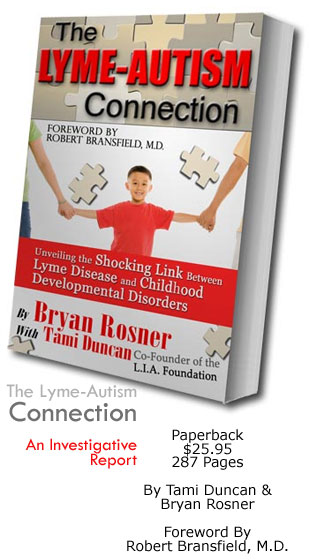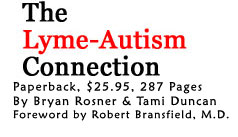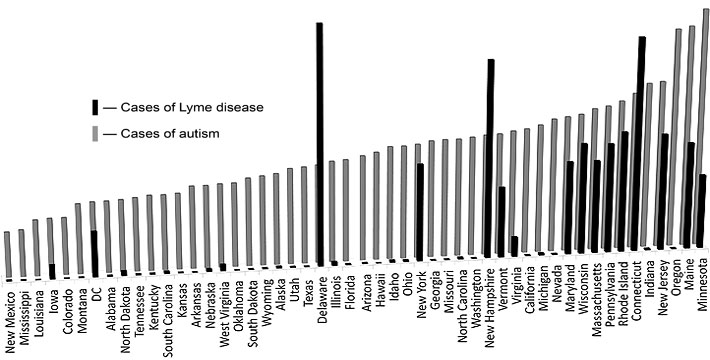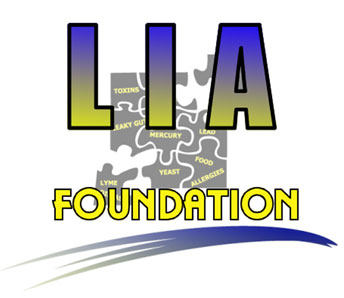|
| |
The
Lyme-Autism Connection Paperback Book
Tami Duncan, co-founder of the
Lyme-Induced Autism (LIA) Foundation and Bryan Rosner have just finished co-writing
a book entitled The
Lyme-Autism Connection: Unveiling the Shocking Link Between Lyme Disease and
Childhood Developmental Disorders. The book was published in June, 2008
and is now available.


AN INVESTIGATIVE REPORT —
The Lyme-Autism Connection, a book written in collaboration with the Lyme-Induced
Autism (LIA) Foundation, provides critical new research on the emerging
science supporting a link between Lyme disease and childhood developmental
disorders.
Awareness of the Lyme-autism
connection is spreading rapidly, among both parents and practitioners. Medical
Hypothesis, a scientific, peer-reviewed journal published by Elsevier,
recently released an influential study entitled "The Association Between
Tick-Borne Infections, Lyme Borreliosis and Autism Spectrum Disorders."
Here is an excerpt from the study:
|
hronic
infectious diseases, including tick-borne infections such as Borrelia
burgdorferi, may have direct effects, promote other infections, and
create a weakened, sensitized and immunologically vulnerable state
during fetal development and infancy, leading to increased
vulnerability for developing autism spectrum disorders.
An
association between Lyme disease and other tick-borne infections and
autistic symptoms has been noted by numerous clinicians and
parents."
—Medical
Hypothesis Journal.
Article Authors: Robert C. Bransfield, M.D., Jeffrey S.
Wulfman, M.D., William T. Harvey, M.D., Anju I. Usman, M.D.
Read the full
article (PDF) |
|
From
the Book's Introduction: The Twin Epidemics
Over the last decade, two disease epidemics have gone
from mild ripples in the water to roaring, ravenous, all-consuming tidal waves,
destroying thousands of lives and tearing apart countless families.
These two diseases are Lyme disease and autism. Until recently, these
afflictions were believed to be unrelated. Actually, that is an understatement.
They were believed to have absolutely nothing in common, occupying distinct and
opposite positions in the medical field. Whereas bronchitis and Strep throat
have some relationship in that they are both infections, Lyme disease and autism
were thought to have nothing in common at all—one is a tick-borne infection
which healthy people contract while camping, and the other is a prenatal brain
development disorder. Recently, however, science has found similarities between
Lyme disease and autism that cannot be ignored. When one looks beneath the
surface of these seemingly diverse disorders, the underlying discoveries are
shocking.
|

“When
a pregnant woman is infected with Lyme disease, not only is she
subject to its devastation, but her baby is too.”
—John
Drulle, M.D.
Urgent care and private practice physician
“Accumulation
of experimental evidence also points to potential for peri-, pre-
and postnatal infections as causes for several neurodevelopmental
disorders such as schizophrenia, autism, cerebral palsy and mental
retardation.”
—Excerpt
from the book “Neuropsychiatric Disorders and Infection,” edited
by Hossein Fatemi, M.D., Ph.D., Associate Professor, University of
Minnesota Medical Center
“An
association between Lyme disease and other tick-borne infections
during fetal development and in infancy with autism, autism spectrum
disorders (ASD) and autistic symptoms has been noted by numerous
clinicians and parents.”
—Medical
Hypothesis journal article written by Robert C. Bransfield, M.D.,
Jeffrey S. Wulfman, M.D., William T. Harvey, M.D., Anju Usman, M.D.
“An
observant parent’s evidence may be disproved but should never be
ignored.”
—Lancet,
1951
“Lyme
produces a micro-edema, or swelling in the brain. This affects your
ability to process information. It’s like finding out that
there’s LSD in the punch, and you’re not sure what’s going to
happen next or if you’re going to be in control of your own
thoughts.”
—Bernard
Raxlen, MD, ILADS
International Lyme & Associated Diseases Society
“Great
diversity of clinical expression of signs and symptoms of
gestational Lyme borreliosis parallels the diversity of prenatal
syphilis. It is documented that transplacental transmission of the
spirochete from mother to fetus is possible…Autopsy and clinical
studies have associated gestational Lyme borreliosis with various
medical problems including fetal death, hydrocephalus,
cardiovascular anomalies, neonatal respiratory distress,
hyperbilirubinemia, intrauterine growth retardation, cortical
blindness, sudden infant death syndrome, and maternal toxemia of
pregnancy.”
—AB
MacDonald, Souhampton Hospital, New York, abstract taken from a 1989
study.
“Relapsing-fever
borreliosis caused by Borrelia duttonii [a strain of Lyme bacteria]
is a common cause of complications of pregnancy, miscarriage, and
neonatal death in sub-Saharan Africa…B. duttonii infection during
pregnancy results in intrauterine growth retardation, as well as
placental damage and inflammation, impaired fetal circulation, and
decreased maternal hemoglobin levels…spirochetes frequently cross
the maternal-fetal barrier, resulting in congenital infection.”
—
Department of Molecular Biology
Umea University, Sweden.
|
Table of Contents - 287 Pages
|
Information for the Reader, 10
Foreword
by Robert Bransfield, M.D., 12
The LIA Foundation, 13
Introduction to this book, 14
PREFACE
Getting Personal with Bryan and Tami
Bryan’s Preface: The
Lyme-Autism Connection Close To Home, 19
Tami’s
Preface: Research and Questions Bring New Hope, 24
CHAPTER
1 Introduction
The Twin Epidemics, 33
An Uphill Battle, 37
The Many Faces of Autism, 41
But Isn't Lyme Disease a Simple Bacteria?, 48
ILADS List: Basic Information About Lyme
Disease, 48
Infection Stew, 52
On The Front Lines, 56
CHAPTER
2 Building the Foundation
Congenital Transfer, 59
Pregnancy
and Lyme Disease, By John Drulle, M.D., 62
Recent Studies,
69
Family Disease Trends, 74
Interpreting the Data and Moving Past the
Genetics Paradigm, 78
Refuting the Inventible Guilt, 80
CHAPTER
3 Immunity and Infections
Building the Case, 83
Autism and Infections, 88
A Few Key Example Infections, 91
CHAPTER
4 Making the Connection
The Antibiotic Clue, 97
The
Primary Lyme-Autism Study, 102
Open Studies, 111
CHAPTER
5 Connecting the Dots: Common Symptomology
Symptoms
vs. Syndromes, 116
Blurred Lines Between Disease Labels, 117
Lyme Disease: The Great Imitator, 119
Autism: The Next Great Imitator?, 121
Autoimmunity, 126
Where the Rubber Meets the Road, 129
CHAPTER
6 Connecting the Dots: Geographic
Distribution
The Correlation Coefficient, 135
Chronological Correlation, 140
Geographical Correlation, 145
CHAPTER
7 Getting Help
Finding a physician, 154
Finding a
Lyme-Literate Medical Doctor (LLMD), 158
Finding an
Autism-Literate Medical Doctor, 159
Using Internet Discussion Groups to Locate a
Physician, 159
Brief Tips for Formulating a Treatment Plan,
160
Treatment Resources, 161
Websites,
162
Books, 164
Closing Argument, 165
APPENDICES
Appendix A: Testing for Lyme Disease and Co-infections, 169
Appendix B: Introduction to Lyme Disease, 179
Appendix C: Testing for and Treating Heavy
Metal Poisoning, 189
Appendix D: The Think Tank Overview, 199
Appendix E: Personal Stories of Mothers and
Families, 224
INDEX
(allow preview a few minutes to load)
|
An
Investigative Report
Written by health care journalist Bryan Rosner and
LIA Foundation co-founder Tami Duncan, this book set out to investigate the
explosive increase in both Lyme disease and autism cases. The book is based on
objective scientific data as well as the vast wisdom and experience of
physicians, researchers and parents. The book was written to explore the simple
question, Is there a significant connection between the exploding rates of Lyme
disease and autism, and if so, what are the mechanics of that connection?
Although the Lyme-autism connection is an area of research that is brand new and
continually developing, there is an ever-increasing amount of information and
science to support the connection hypothesis. The following are some of the
discoveries which were made by the authors and presented in the book:
-
Studies
spanning the last 30 years have shown that Borrelia burgdorferi (the
causative bacteria in Lyme disease) can be transmitted from mother to baby
during pregnancy, resulting in early childhood infection. John Drulle, M.D.,
conducted pioneering research in this area in the 1990's—his work is
included in the book.
-
Autism
causes many of the same immune system irregularities that are also present
in Lyme disease.
-
Numerous
infections appear to be involved in autism, not just Borrelia burgdorferi.
Borrelia appears to be one of the more important infections due to its
skyrocketing prevalence and epidemic proportions.
-
The
Lyme-autism connection has been substantiated by clinical experience, both
in the physician’s office and at home among numerous observant mothers and
fathers.
-
The
symptoms of Lyme disease overlap with the symptoms of autism, and in fact,
the two diseases share in common many of the same “mimicking
diagnoses,” especially mental disorders, such as schizophrenia,
obsessive compulsive disorder, depression, and attention deficit disorder
(ADD). Both Lyme disease and autism are characterized by clustering of these
diseases within family histories.
-
The
Lyme-autism connection is being studied with increasing frequency, by
researchers with an ever-growing list of qualifications and credentials. See
video previews to your right.
-
The
Lyme-autism connection is comprised of not one or two elements, but instead,
numerous puzzle pieces which support one another to create and substantiate
the connection hypothesis.
-
If
you intend to take action and apply Lyme disease treatment to your child,
please do so only under the supervision of a licensed physician. The
book provides guidelines for finding a helpful physician.
-
This
field is evolving rapidly. To stay up to date, keep connected with the LIA
Foundation, www.liafoundation.org.
Parents themselves are on the
front lines of this emerging area of research. In the words of one parent with
three autistic children:
"Childhood
autism has become so prevalent that there are very few who do not know of a
family with an autistic child. Families with two autistic children are not
uncommon, and I personally have seen a family in which all three of the
family’s children were autistic (very much like mine).
The
latest statistics estimate that over one half million American children are
autistic, and with numbers steadily growing, there is no end in sight.
It
can be expected that treatments will improve the outlook of these children,
but many or most of them will require custodial care for life, at an average
cost to society as much as three million dollars per child. Something must
be stirring this explosive epidemic on, and one of the factors which has
been greatly overlooked is the Lyme-autism connection."
—Kathy Blanco
Mother of 3 autistic children,
Contributing Writer, and one of the
first researchers to discover the Lyme-Autism connection |
Are
Genetics or Infections to Blame for the Autism Epidemic?
Bryan and Tami asked the following questions: Why
would cases of autism skyrocket over the past couple of decades? If autism is a
genetic disorder, as it has been previously believed, how could such a rapid
increase occur? Genetic disorders rarely involve such non-linear, exponential
explosions in occurrence. Genes just don’t change that fast. Infectious
epidemics, on the other hand, such as Lyme disease, can and do cause exponential
increases in disease cases. Also, why do the cases of autism continue to
skyrocket even after mercury has been taken out of vaccines, and even in
children who were never vaccinated?
Statistics show a strong correlation (as defined mathematically with correlation
coefficient) between the rising incidence of autism and the rising incidence of
Lyme disease from 1992 to 2006. There is also a significant correlation (as
defined mathematically with correlation coefficient) between the geographic
distribution of autism and Lyme disease cases (See
Figure 1 below). This data alone is enough to raise eyebrows.
|

FIGURE 1
(view
enlarged figure)
This figure compares cases of
Lyme disease with cases of autism in the United States during the
2006-2007 school year. Cases
of Lyme disease are indicated by black bars and cases of autism are
indicated by gray bars. Observe how the states with
the highest incidence of autism are the same states with the highest
incidence of Lyme disease. This unmistakable and shocking
"clumping"
of disease cases in the same states was one of the major findings of
the Lyme-autism study.
Sources:
Thoughtful House Center for Children / Fighting Autism Foundation
(autism statistics)
United States Centers for Disease Control (CDC) (Lyme disease
statistics)
|
Of course, mere statistical correlation (as seen
above in Figure 1) between the incidence and
distribution of Lyme disease and autism is not enough to use as a foundation for
causation. If you recall your college statistics class, correlation does not
necessarily imply causation.
However, when the strong, but not necessarily conclusive, correlations between
autism data and Lyme disease data are combined with other factors such as
symptomology, epidemiology, family history, and other factors we explore in this
book, a very strong argument can be built for the case that similarities between
Lyme disease and autism move beyond the realm of correlation into the territory
of causation.
For these reasons, the Lyme-autism connection is gaining momentum and public
awareness rapidly. Well respected researchers, physicians, and organizations are
beginning to take a second look at what might be the biggest infectious disease
discovery of the century.
We invite you
to explore the shocking data with us.
Awaiting your discovery is the Lyme-Autism Connection.
| |
Written,
produced, and sold
in collaboration with
The LIA Foundation
 |
Now Available! Published July
1, 2008
THE LYME-AUTISM CONNECTION
By Bryan Rosner
With Tami Duncan
Foreword by Robert Bransfield, M.D.
Paperback Book, 287 Pages, $25.95
|
| Ordering
Options: |
|
|
Order By Phone:
(530) 541-7200
|
Order Online:

|
|